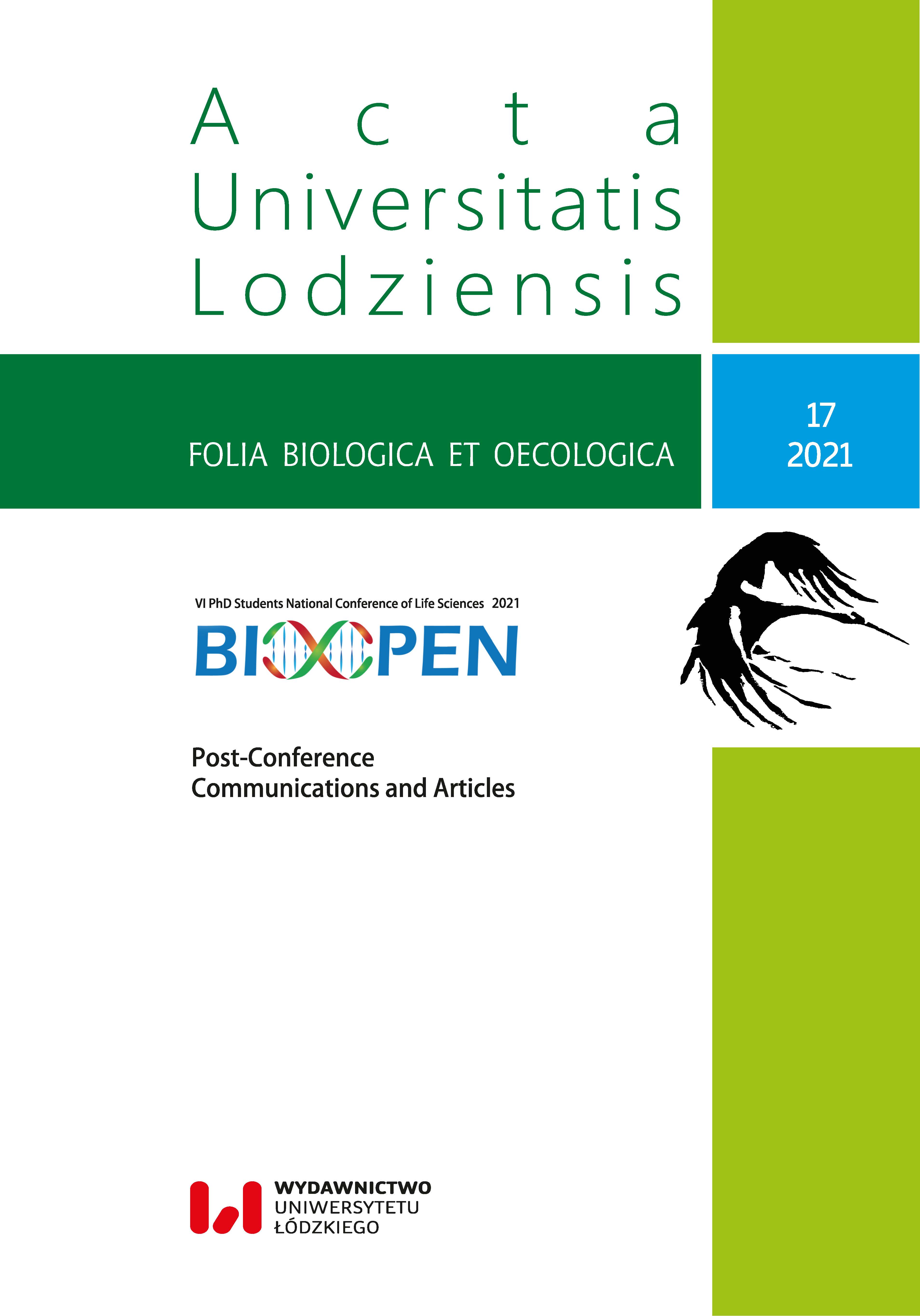Comparison of the antioxidant potential of some herbal teas produced from ecological and traditional crops
DOI:
https://doi.org/10.18778/1730-2366.16.20Słowa kluczowe:
free radicals, organic cultivation, antiradical activity, polyphenols content, oxidative stressAbstrakt
The growing public awareness of the dangers regarding chemicals used in traditional agriculture has led to consumers seeking valuable and contaminant-free products. Ecological agriculture has become synonymous with high health value and product safety. The aim of this study was to evaluate the antioxidant activity and the total polyphenolic content of infusions of herbal tea bags and loose teas from traditional crops, as well as infusions of loose teas from ecological crops. Raw material comprised dried flowers of Matricaria chamomilla and Tilia cordata, as well as dried leaves of Urtica dioica, Melissa officinalis and Mentha piperita. Herbal infusions were prepared using three brewing times: 5, 10 and 20 min. The analysis of antioxidant potential was performed using in vitro methods such as DPPH, ABTS and FRAP. The polyphenolic content was determined using the Folin-Ciocalteu method. The antioxidant activity of the studied tea infusion depended on the method by which the plants were cultivated and the brewing time. The ecological agriculture conditions seem not to stimulate the synthesis of antioxidants. However, the possibility to obtain other beneficial properties of the studied plants is an indication to carry out ecological cultivation.
Pobrania
Bibliografia
Caverzan, A., Casassola, A., Brammer, S.P. 2016. Antioxidant responses of wheat plants under stress. Genetics and Molecular Biology, 39: 1–6.
Google Scholar
DOI: https://doi.org/10.1590/1678-4685-GMB-2015-0109
Grabowska, K., Dymerska, A., Pożarska, K., Grabowski J. 2016. Prognozowanie plonów łubinu wąskolistnego w oparciu o wybrane scenariusze zmian klimatu. Acta Agrophysica, 23: 363–380.
Google Scholar
Gulumian, M., Yahaya, E.S., Steenkamp, V. 2018. African herbal remedies with antioxidant activity: a potential resource base for wound treatment. Evidence-Based Complementary and Alternative Medicine; 4: 1–58.
Google Scholar
DOI: https://doi.org/10.1155/2018/4089541
Hallmann, E., Rembiałkowska E. 2007. Zawartość wybranych składników odżywczych w czerwonych odmianach cebuli z uprawy ekologicznej i konwencjonalnej. Żywność Nauka Technologia Jakość, 14: 105–111.
Google Scholar
Jiang, C-J., Huang, J-W., Jie, C., Yan, C., Li, Y-T., Kurihara, H., Li, Y-F., He, R-R. 2018. Wanglaoji herbal tea protects against influenza-induced pneumonia in restraint-stressed mice via its anti-inflammatory effects. International Journal of Pharmacology, 14: 342–351.
Google Scholar
DOI: https://doi.org/10.3923/ijp.2018.342.351
Kapoulas, N., Koukounaras, A., Ilić, Z. 2017. Nutritional quality of lettuce and onion as companion plants from organic and conventional production in north Greece. Scientia Horticulturae, 219: 310–318.
Google Scholar
DOI: https://doi.org/10.1016/j.scienta.2017.03.027
Kazimierczak, R., Hallmann, E., Sokołowska, O., Rembiałkowska, E. 2011. Zawartość związków bioaktywnych w roślinach zielarskich z uprawy ekologicznej i konwencjonalnej. Journal of Research and Applications in Agricultural Engineering, 56: 200–205.
Google Scholar
Kazimierczak, R., Hallmann, E., Zduńska, U. 2017. Wpływ systemu produkcji na zawartość wybranych związków bioaktywnych w przyprawach ziołowych. Postępy Techniki Przetwórstwa Spożywczego, 1: 46–50.
Google Scholar
Kędzia, B., Hołderna-Kędzia, E. 2018. Zastosowanie miodu i roślin leczniczych w chorobach ośrodkowego układu nerwowego. Postępy Fitoterapii, 19: 128–133.
Google Scholar
DOI: https://doi.org/10.25121/PF.2018.19.2.128
Kohlmünzer , S. 2007. Farmakognozja. Wydawnictwo Lekarskie PZWL, Warszawa.
Google Scholar
Magdoff, F. 2007. Ecological agriculture: Principles, practices, and constraints. Renewable Agriculture and Food Systems, 22: 109–117.
Google Scholar
DOI: https://doi.org/10.1017/S1742170507001846
Muzykiewicz, A., Zielonka-Brzezicka, J., Klimowicz, A., Florkowska, K. 2017. Jarząb pospolity (Sorbusaucupari a L.) jako źródło składników o potencjalnym działaniu antyoksydacyjnym – porównanie właściwości przeciwutleniających ekstraktów z liści, kwiatów i owoców. Problemy Higieny i Epidemiologii, 98: 125–132.
Google Scholar
Muzykiewicz, A., Zielonka-Brzezicka, J., Klimowicz, A. 2018. Quince (Cydonia oblonga Mill.) as a useful source of antioxidants – Antioxidant activity evaluation. Herba Polonica, 64: 23–33.
Google Scholar
DOI: https://doi.org/10.2478/hepo-2018-0020
Parkash, J., Prasad, D.N., Shahnaz, M., Dev, D. 2018. Herbs as traditional medicines: a review. Journal of Drug Delivery and Therapeutics, 8: 146–150.
Google Scholar
DOI: https://doi.org/10.22270/jddt.v8i5.1910
Pełczyński, S. 1993. 350 recept zielarzy rosyjskich. Interlibro, Warszawa.
Google Scholar
Piotrowski, K., Romanowska-Duda, Z., Messyasz, B. 2020. Cultivation of energy crops by ecological methods under the conditions of global climate and environmental changes with the use of diatom extract as a natural source of chemical compounds. Acta Physiologiae Plantarum 2020, 42: 146.
Google Scholar
DOI: https://doi.org/10.1007/s11738-020-03135-8
Rasul, G., Gopal, T. 2004. Sustainability of ecological and conventional agricultural systems in Bangladesh: an assessment based on environmental, economic and social perspectives. Agricultural Systems, 79: 327–351.
Google Scholar
DOI: https://doi.org/10.1016/S0308-521X(03)00090-8
Reganold, J.P., Wachter, J.M. 2016. Organic agriculture in the twenty-first century. Nature Plants, 2: 1–8.
Google Scholar
DOI: https://doi.org/10.1038/nplants.2015.221
Rembiałkowska, E., Hallmann, E., Wasiak-Zys, G. 2003. Jakość odżywcza i sensoryczna pomidorów z uprawy ekologicznej i konwencjonalnej. Żywienie Człowieka i Metabolizm, 30: 893–899.
Google Scholar
Śmiechowska, M., Florek, A. 2011. Content of heavy metals in selected vegetables from conventional, organic and allotment cultivation. Journal of Research and Applications in Agricultural Engineering, 56: 152–156.
Google Scholar
Zargoosh, Z., Ghavam, M., Bacchetta, G., Tavili, A. 2019. Effects of ecological factors on the antioxidant potential and total phenol content of Scrophularia striata Boiss. Scientific Reports, 9: 16021.
Google Scholar
DOI: https://doi.org/10.1038/s41598-019-52605-8
Pobrania
Opublikowane
Jak cytować
Numer
Dział
Licencja

Utwór dostępny jest na licencji Creative Commons Uznanie autorstwa – Użycie niekomercyjne – Bez utworów zależnych 4.0 Międzynarodowe.









